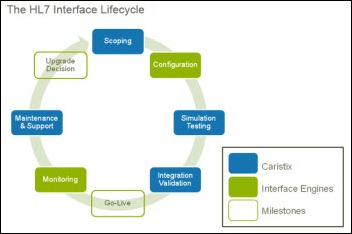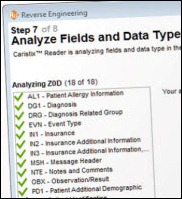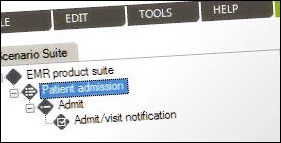HIStalk Innovator Showcase–Caristix
Company Name: Caristix
Address: 1400 St-Jean-Baptiste Avenue, Suite 204, Quebec City, QC G2E 5B7
Web Address: www.caristix.com
Telephone: 877.872.0027
Year Founded: 2009
FTEs: 5
Elevator Pitch
The Caristix HL7 software suite helps healthcare IT vendors and hospitals reduce interface deployment from months of work to a few days.
Business and Product Summary
Caristix develops software for healthcare IT analysts and developers. With a focus on HL7 and data mining, Caristix streamlines the delivery of interfaces that support the flow of data in healthcare. If we look at innovation in this space, we took a leap forward about 15-20 years ago with the introduction of interface engines. The next leap forward is going to come from automating the manual scoping and configuration work involved in interfacing, leaving integration analysts free to add value on other more complex data integration topics.
With our software offering, we help vendors and providers scope HL7 interface requirements more quickly before coding, test more thoroughly before go-live, and troubleshoot over the interface lifecycle. Benefits to vendors and providers include lower interfacing costs, faster time to value, and reduced process waste and risk. We provide annual licenses that include support and maintenance releases. We also offer services, such as creating interface specifications for our customers, and getting them started on documentation and interfacing best practices.
Target Customer
HIT software and service providers, hospitals and IDNs, and HIEs.
Customer Problem Solved
The biggest bottleneck in HL7 interfacing isn’t coding or setting up the interface. With modern interface engines, that’s easy. What’s hard is figuring out what to code. In other words, which data should you handle and what does each piece look like in the real world (not on paper in the spec)? Our software figures out what to code automatically.
The way the industry solves this problem today isn’t going to work for much longer, especially with volume of data enabled through Meaningful Use. Right now, folks are essentially using trial and error. In other words, you set up an interface based on a site survey form and a broad product spec, connect up to a test system to get some data coming in, see what’s broken, then fix it. Rinse and repeat. If you’re lucky, you’ll make your schedule. If you’re not, you might be six months out. If you decide to go live anyway, the vendor and/or the hospital’s IT team will be facing one heck of a support backlog, which in turn, can tank adoption rates.
Trial and error is increasingly problematic with today’s interfacing volumes. It’s certainly going to get tougher to sustain once Meaningful Use forces real data integration, with multiple sources of clinical data coming into and going out of the EHR and other information systems. We’re seeing early-adopter vendors and hospitals moving away from trial and error. We think we’ve hit a sweet spot with our software. We’ve come up with a way to not only get proactive on scoping, but also keep scoping documentation up to date for future integration projects.
Competitors
Our competitors are niche tool vendors and a few of the interface engine vendors. However, that second category includes a little overlap: we also complement interface / integration engines and are working with two vendors in this space. But our biggest competitor is the status quo, folks just going along with business as usual.
Advantages Over Competitors
We integrate data mining so analysts can easily grasp their data and what it means. This can drive up interface quality while driving down project risk. The functionality we provide around HL7 data helps interface analysts to grasp sending and receiving system specifications easily. This enables analysts to identify gaps to be bridged by interfacing and integration early during a project. With complex interfacing and integration projects, project leaders can increase interface quality and confidence without jeopardizing timelines.
Fast Facts
- KISS (Keep It Simple…) If our spouses let us, the founders would tattoo “KISS” on our respective foreheads. At Caristix, we really want to keep things simple for our customers.
- We’re concentrating on HL7 for now. But keep an eye on us for other data standards over the next year.
- We’re an experienced healthcare IT team and we have a shared work history. Some of us even go back 12 years, and our team brings over 50 years of combined experience, in both technical and business areas in healthcare IT.
- The company has a product management focus. In other words, our products reflect market and user needs and where we think the market is going. As a startup, the last thing we’re interested in is the tech fantasy of “build it and they will come.”
- Here is a customer quote: “This is the only tool that provides me with the filter functionality needed to successfully dissect thousands of transactions and find all of the deltas, without jeopardizing timelines.”
Pitch Video Created Specifically for this Showcase
Customer Interview (a system analyst for a large healthcare IT software vendor)
What problems have you solved using Caristix products and what impact has that had on your organization?
We are seeking ways to continuously improve our customer enablement process for our product. An activity in that process is understanding the customer environment. The Caristix Conformance product assist the SME knowledge of their environment and not to rely on outdated documentation and assumptions. Conformance gives us (and the customers) a great visual of their environment.
With this improved visibility, we reduced the rationalization logistic interactions – a lengthy Q/A process (i.e. what systems are involved in the project? what data comes from that system? <<…implementation period…>> Are you sure? Well, we’re seeing this type of data and it does not agree with the initial statements. Are there any more surprises? etc.). This form of interaction occurs over weeks or months and creates much re-work as information becomes known. Knowing upfront the true reality not only mitigates loss time (and financial expenditures), but also improves customer satisfaction and overall product experience.
Caristix also has other products which we review:
- Cloak, which de-identifies data – another great product in the making. One colleague commented, “… this is the simplest interface I’ve ever used…”
- Pinpoint, which enables what I call “finding a needle in a haystack” simple. Pinpoint cut so much time out finding what’s occurring within the data flow, it’s amazing! One colleague said, “…I wish I had this product when dealing with customer ABC — it would have saved me days of work.”
- Although we have not looked at their other products, based on the ones we did, I’m confident they pointedly address the intended concerns.
What alternatives or competing products did you consider and why did you choose Caristix?
We searched for products that address our specific concerns, but didn’t find any. Also, as we began to use the product, the company was open to our product improvement suggestions. And the most amazing thing occurred — they not only implemented the suggestions, but also saw the general benefits to other users as well. Their turnaround time to implement was truly Agile. We saw results in weeks, not months or worst, year(s). As Conformance continues to mature with new features, plus the incorporation of the suggestions, I foresee retiring some of our legacy tools.
How would you complete this sentence if speaking to a peer? "I would recommend that you take a look at Caristix under these circumstances:"
If you are looking for a company who really wants to work with you to solve the problems that their product set addresses, then certainly call Caristix. They truly try to understand the customer use cases, see how (and which product(s)) can meet those needs. And on the rare occasion when their isn’t a “match,” they are upfront to let you know, but still try to see if it’s possible within their reach.
Their response is impeccable, from showing you mock-up to real running code. They are willing to see how your suggestion can make their product better. The proof is when you see the implemented result! Now that’s amazing! Their Say:Do ratio is on par.
They have a good idea where the market is progressing and are making plans to be there as you review their product roadmap. I believe they are flexible enough to make the necessary course corrections as they occur.
An Interview with Stéphane Vigot, President, Caristix

HL7 interfacing sounds simple, at least on paper. Why do organizations need your products?
HL7 is called a standard, but it’s more of a framework. It’s extremely flexible. You’ve got some guidance regarding the way you could organize the data, but each and every hospital adapts the organization of the data to its clinical workflows.
For example, if you consider the admit status sex of a patient, you can have up to six different possibilities. There are very, very few systems that would use those six possibilities. Most of them will use three or four, and even when they pick only three or four, let’s say for a male and a female, one could say, “OK, a male is designated as an M and a female as an F,” or another will say, “In my organization, we’d rather use an 1 and a 2.” That’s a real example.
For any kind of field, you’ve got a type of flexibility. Even though two hospitals are using the very same ADT system, let’s say – admission, discharge and transfer — and they use the very same vendor, the very same version of the system, the data will most likely be organized in a different way.
Thanks to our technology, instead of having an interface analyst looking and reading, literally, HL7 messages, we get the feed from the system that you have to connect. In a matter of a few minutes, we do some reverse engineering on the metadata and then we issue a document that will very precisely tell you how the data is organized within a system.
With interfaces, you often just play back a bunch of messages and try to figure out all the exceptions and rules, with an application expert on one side an an interface expert on the other. How would a hospital use your product to create their own interoperability?
They would get the software platform that we have. They would get HL7 logs, so basically several HL7 messages, and they can deal with tens of thousands of different messages. They would put that file into our platform, and then automatically the platform will do a reverse engineering process. It will read the data and issue a Word document that will tell you precisely how the data is organized.
Then the technician, either from their vendor side or from the hospital side, will know exactly how to configure the interface engine. They will know exactly what data is what and how it is organized — the length of the field and everything. That’s basically it. It’s a very straightforward application that saves hours and sometimes days or weeks of work for an interface analyst. We’ve got a customer testimonial where a task that usually took up to eight hours is done in three minutes, thanks to our platform.
Does the typical customer buy your product just for a specific interface problem they’re trying to solve, or is it in their tool chest of things that they end up using a lot?
They end up using it a lot, because an average hospital in the US will usually deal with more than 100 interfaces. Every single time there is an update to any of the systems they’re using, then the interface will need to be adapted to the update. We know hospitals that have up to five persons dedicated to managing the interfaces. That’s what they do all day long. That’s why our platform can be used on a daily basis.
How would a customer use your product to validate the integrity of an interface, either a new one or an existing one to make sure nothing has changed?
They will just get the logs, do a reverse engineering on the new or existing system, and perform gap analysis between the current interface, or on the old interface if you will, and then the new interface that they want to build. There’s a built-in functionality within our platform that allows you to perform in a matter of a few minutes a gap analysis between two specifications.
You’re based in Canada. Do you see any particular challenges that you’ll face when working with the US?
It’s our target market. In fact, 80% of our customers are in the US. Historically, the team of Caristix worked for a major US vendor for a number of years. The genesis of Caristix was because of a reduction of forces — we had to let go several software developers that were working for that US vendor, so our expertise was really in the US.
Who is it you market to and how do you reach those people?
We market to two segments: hospital vendors and hospitals. We are currently working on a free application for hospitals that will allow the hospital’s IT teams to document the specification of the different systems, again, in a matter of a few minutes.
We use a lot of white papers, we use a lot of reference, if you will. Since we’ve been working with US companies for years, we know a lot of them, so that’s how we reach out to them. We’re now getting more visibility and we’ve got some consultants — or I’d say gurus — in healthcare IT that are also talking a lot about us.
The nice thing about our platform is that once you see how it works, you automatically understand the benefits and you automatically understand the savings that as a vendor or even as a hospital you’re going to be able to make. I’d say it’s an easy sell. As soon as you talk to people who know and understand the complexity of HL7 Interfacing, it’s almost – and I hate to use this term – but it’s almost a walk in the park from a sales standpoint.
What do you hope to gain from the exposure on my site?
Any hospital is dealing with HL7. You’re extremely visible in the HIT world. I was at HIMSS this year – I’ve been attending for the past seven years – and a lot of people know Mr. HIStalk. You’ve got quite some followers there. I think that’s going to provide us a lot of visibility.
Most of the people who are dealing with HL7 interfacing will definitely take a look at our website. When they take a look, we’ve got a great response and they automatically understand what we do. The savings are very positive. That’s where we see a lot of potential, and thanks to your help, we see a lot of lead generation, thanks to the HIStalk blog.
The feedback we’re getting from existing customers is that within their first interface project, the return on investment is immediate. You don’t have to be using our platform for months to get to see the benefits. It almost pays for itself with the first project.








Giving a patient medications in the ER, having them pop positive on a test, and then withholding further medications because…